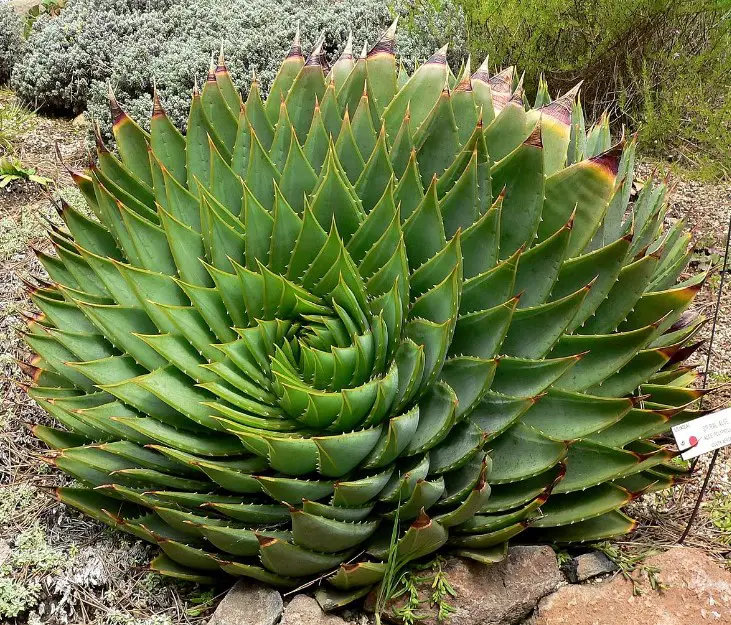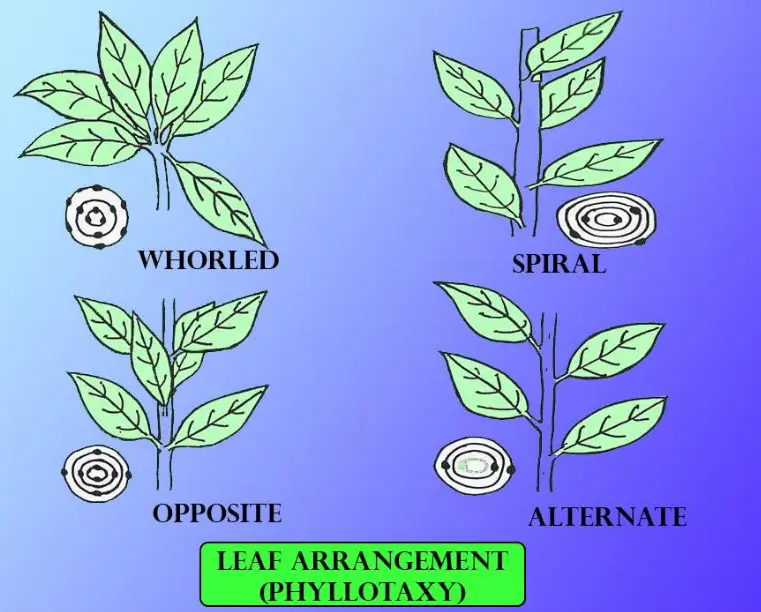Phyllotaxy, the pattern of leaf arrangement on a plant stem, is a fundamental aspect of plant morphology that influences a plant’s ability to capture light, undergo photosynthesis, and interact with its environment. This seemingly simple aspect of plant structure has profound implications for a plant’s growth, health, and evolutionary success. By examining the differences between alternate and whorled phyllotaxy, we can gain insights into the diverse strategies plants employ to thrive in a variety of ecological niches.
Alternate phyllotaxy involves a single leaf emerging at each node in a spiral or alternate fashion along the stem, maximizing light exposure and reducing competition among leaves. Whorled phyllotaxy, on the other hand, features multiple leaves growing at a single node, creating a symmetrical arrangement that can enhance the plant’s ability to capture sunlight from different angles. These two types of leaf arrangement offer distinct advantages and reflect the plant’s adaptation to its specific environment.
The study of phyllotaxy not only unveils the intricacies of plant development and adaptation but also provides valuable insights into ecological balance, agricultural practices, and horticultural design. By understanding the characteristics and benefits of alternate and whorled phyllotaxy, we can better appreciate the complexity and beauty of the plant world, as well as its critical role in sustaining life on Earth.

Phyllotaxy Basics
What Is Phyllotaxy?
Phyllotaxy is the pattern of leaf arrangement on the stem of a plant. This concept is crucial in plant biology because it affects a plant’s growth, health, and ability to perform photosynthesis. Essentially, phyllotaxy determines how leaves are spaced out along the stem, which influences how well a plant can capture sunlight, shade its fruit, and even how it interacts with the wind.
Types of Phyllotaxy
There are several types of phyllotaxy, each offering different advantages to the plant. The most common types include:
- Alternate: A single leaf grows at each node, alternating sides along the stem.
- Opposite: Two leaves emerge at the same node on opposite sides of the stem.
- Whorled: Three or more leaves grow at a single node.
- Spiral: Leaves are arranged in a spiral pattern around the stem, which is a variation of alternate phyllotaxy.
Each type plays a role in optimizing a plant’s exposure to light and its overall health.
Alternate Phyllotaxy
Definition
Alternate phyllotaxy is a leaf arrangement where each node along the plant stem bears a single leaf. This pattern creates a spiral or zigzag formation as the leaves alternate sides up the stem.
Characteristics
Key Features and Examples
- Spiral Pattern: Leaves grow in a spiral, ensuring minimal overlap.
- Light Optimization: This arrangement maximizes light exposure.
- Examples: Elm trees, oak trees, and cherry trees exhibit this type of phyllotaxy.
Advantages
Ecological and Biological Benefits
- Reduced Competition: Leaves don’t shade each other, reducing competition for sunlight.
- Efficient Photosynthesis: Optimal light exposure enhances photosynthesis.
- Water Drainage: This pattern aids in better water drainage from leaves, reducing the risk of disease.
Whorled Phyllotaxy
Definition
Whorled phyllotaxy refers to a leaf arrangement where three or more leaves grow at a single node on the plant stem. This creates a symmetrical pattern around the stem.
Characteristics
Key Features and Examples
- Symmetrical Pattern: Leaves are evenly spaced around the stem.
- Dense Foliage: This arrangement can support denser foliage.
- Examples: Milkweed and some species of lilies are known for their whorled phyllotaxy.
Advantages
Ecological and Biological Benefits
- Enhanced Sunlight Capture: The symmetrical arrangement allows plants to capture sunlight from multiple angles.
- Aesthetic Appeal: Whorled patterns are often considered visually appealing, which is beneficial in horticulture.
- Adaptation to Environments: This type can be an adaptation to environments where light is scarce or comes from various angles.
Comparing Alternate and Whorled Phyllotaxy
Leaf Arrangement
Differences in Leaf Arrangement
The primary distinction between alternate and whorled phyllotaxy lies in the pattern of leaf emergence along the plant stem. In alternate phyllotaxy, leaves are placed one per node, alternating sides as they ascend the stem, creating a spiral or zigzag pattern. This arrangement ensures minimal overlap, allowing each leaf to receive ample sunlight and air. On the other hand, whorled phyllotaxy features three or more leaves emerging from a single node, encircling the stem in a symmetrical pattern. This arrangement can create a dense canopy of leaves, capturing light from multiple directions but potentially leading to more competition among leaves for sunlight.
Ecological Impacts
How Each Type Affects the Plant’s Environment
Alternate and whorled phyllotaxy have distinct ecological impacts due to their differing arrangements:
- Light Distribution: Alternate phyllotaxy maximizes light exposure and minimizes shading of lower leaves, which is crucial in densely forested areas or competitive ecosystems. Whorled phyllotaxy, with its symmetrical arrangement, can capture diffuse light more effectively, beneficial in open areas or lower light conditions.
- Water Drainage: The spiral pattern of alternate phyllotaxy helps in directing water away from the stem, reducing the risk of fungal diseases. Whorled arrangements might trap moisture, requiring well-aerated environments to prevent issues.
- Wind Resistance: The streamlined pattern of alternate phyllotaxy offers less wind resistance, which reduces the risk of damage during storms. Whorled arrangements, due to denser foliage, might catch more wind, which could lead to stem breakage or uprooting in extreme conditions.
Adaptations
Evolutionary Adaptations of Each Phyllotaxy Type
Plants with alternate phyllotaxy have adapted to maximize individual leaf exposure to sunlight and efficient water drainage, making them well-suited to environments where light and water availability fluctuate. In contrast, plants with whorled phyllotaxy are adapted to make the most out of their environmental conditions, such as capturing scattered light in understory environments or maximizing photosynthesis in open, sun-drenched areas. These adaptations highlight the evolutionary strategy of plants to optimize their growth and survival based on their specific ecological niches.
Practical Implications
In Agriculture
Impact on Crop Management and Yield
Understanding phyllotaxy can significantly impact agricultural practices and crop yields. For crops exhibiting alternate phyllotaxy, such as many fruit trees and grain-producing plants, farmers can tailor pruning and planting strategies to ensure each leaf receives optimal sunlight, thereby enhancing photosynthesis and fruit production. For crops with whorled phyllotaxy, such as certain leafy greens and ornamentals, spacing and canopy management become crucial to avoid overcrowding and to maximize light penetration to each layer of leaves. This knowledge allows for more effective crop management strategies, potentially leading to higher yields and better-quality produce.
In Horticulture
Considerations for Garden Design and Plant Selection
For gardeners and landscape designers, understanding the differences between alternate and whorled phyllotaxy can aid in selecting the right plants for specific locations and purposes. Alternate phyllotaxy plants are often chosen for areas where elegant, unobstructed growth is desired, allowing each plant to express its natural habit without excessive crowding. Plants with whorled phyllotaxy, with their often lush and symmetrical growth, are frequently used as focal points in garden designs or in situations where a dense canopy or ground cover is desired. Additionally, recognizing the water and light needs based on phyllotaxy can help in creating more sustainable and low-maintenance garden designs that align with the natural environment.
Frequently Asked Questions
What is Phyllotaxy?
Phyllotaxy refers to the pattern or arrangement of leaves on the stem of a plant. This arrangement plays a crucial role in optimizing light exposure, minimizing leaf overlap, and enhancing a plant’s photosynthetic efficiency. Understanding phyllotaxy helps in studying plant growth, development, and ecological adaptations.
Why is Alternate Phyllotaxy Beneficial?
Alternate phyllotaxy is beneficial as it reduces competition among leaves for sunlight, maximizes photosynthesis, and promotes efficient water drainage from the plant. This arrangement allows for optimal spacing between leaves, ensuring each leaf has access to adequate light and air circulation.
How Does Whorled Phyllotaxy Differ from Alternate?
Whorled phyllotaxy differs from alternate by having multiple leaves grow at a single node around the stem, compared to the one leaf per node pattern of alternate phyllotaxy. This creates a symmetrical arrangement that can potentially increase a plant’s ability to capture sunlight and support denser foliage.
Can Phyllotaxy Affect a Plant’s Health?
Yes, phyllotaxy can significantly affect a plant’s health. The arrangement of leaves influences light penetration, air circulation, and moisture retention, directly impacting photosynthesis, transpiration, and susceptibility to diseases. A well-adapted phyllotaxy can enhance a plant’s vitality and productivity.
Conclusion
Understanding the differences between alternate and whorled phyllotaxy offers fascinating insights into the adaptive strategies plants employ to optimize light capture, support photosynthesis, and ensure survival in diverse environments. This knowledge not only deepens our appreciation for the complexity of plant life but also has practical implications for agriculture, horticulture, and environmental conservation.
The study of phyllotaxy bridges the gap between basic botanical science and its application, highlighting the intricate relationship between plant form, function, and habitat. As we continue to explore the natural world, recognizing the significance of phyllotaxy enriches our understanding of plant biodiversity and the ecological balance necessary for sustaining life on our planet.

